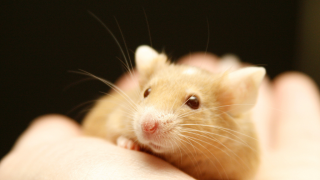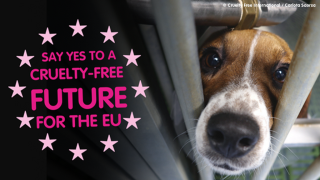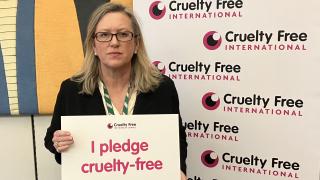EU legislation requiring cruel rabbit tests is axed
We’re delighted that Europe has voted to remove the requirement for the cruel Draize irritation tests on rabbits from EU chemicals legislation REACH. This comes after over three years of lobbying by our scientists.
At the end of December, a committee in Brussels – the REACH Committee - voted in the changes which will come into effect this year.
The changes could mean that 18,000 rabbits are now spared the horror of chemicals being dripped into their eyes or rubbed on their skin.1
REACH was the last EU safety legislation to explicitly request the Draize tests.2
The changes mean that companies are no longer asked to carry out skin and eye irritation tests on rabbits.3 Instead, alternative tests based on human tissues or eyes taken from slaughter houses must be used, rather than tests on conscious rabbits.
Cruelty Free International has been asking the Commission to update REACH Annexes VII and VIII since at least 2012. We are frustrated that it has taken so long and we do not believe it would have happened without our explicit request.
The skin irritation alternatives should have been used by companies to test their chemicals since 2009, when they were adopted by the EU Test Methods Regulation. But the REACH legislation was never updated so companies remained unclear as to whether their data would be accepted if they used the alternatives.
Since then approximately 5,000 rabbits per year have been used in Europe for skin and eye irritation tests.4 Had the Commission acted earlier, thousands of rabbits could have been spared.
Since REACH was the last piece of EU legislation to require the rabbit tests we now anticipate very few tests should be done. We will continue to monitor this and push regulatory authorities to properly enforce the use of alternatives.
The changes also mean that acute dermal toxicity tests are now no longer required for an estimated 80% of substances without this information already. This move will potentially save a further 66,400 rats or rabbits.5
Unfortunately, the Committee failed to remove the mouse local lymph node assay for skin sensitisation (allergy). We believe this was because regulators are too cautious about the available new alternative test methods. REACH already permits companies to use these alternatives, but we will now be working to ensure that they MUST be used.
Sources:
- Based on an EU Commission (2003) estimate that 83% of an estimated 5,000 Annex VIII substances to be registered by 2018 would not have data for (any) of the endpoints (= 4150 substances). We consider this an underestimation of the number of substances likely to be registered. Skin irritation tests use 3 rabbits per substance = saving of 12,450 rabbits. For eye irritation the situation is more complex as the methods can only detect severe irritants and non-irritants. 80% of chemicals are thought to be non-irritant, the in vitro methods tend to over classify a proportion of these as irritant, but are correct at identifying severe irritants (estimated at 15% of substances); estimated test reduction of 50% (see Scott et al. 2010 and OECD). Eye irritation tests use 3 rabbits per substance = saving 6,225 rabbits.
- Biocides (regulation 528/2012 ) and Plant Protection Products (regulation 544/2011) already referred to the testing strategy that leads to avoidance of the animal test rather than the animal test; medicines legislation and cosmetics legislation do not specify any particular test.
- This was a requirement in column 1 of Annex VIII of REACH.
- 2,080 rabbits used in eye irritation tests and 3,151 rabbits were used in skin irritation tests across the EU in 2011, according to the latest official statistics from the European Commission.
- An acute dermal toxicity test can now be explicitly waived if the oral toxicity of the substance is less than 2,000 mg/kg bw/d. The Commission estimates that this might apply to 80% of chemicals to be registered by 2018 which do not already have this data. Acute dermal toxicity tests use approximately 20 rats or rabbits per substance = saving 66,400 animals.












